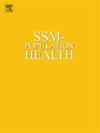秘鲁抑郁症症状和治疗可及性的社会经济和空间分布:2014年至2021年全国重复横断面研究
IF 3.6
2区 医学
Q1 PUBLIC, ENVIRONMENTAL & OCCUPATIONAL HEALTH
引用次数: 0
摘要
背景:在全球范围内,有证据表明,贫困和地理环境影响抑郁症状的流行和获得治疗的机会。因此,本研究旨在评估秘鲁抑郁症状和治疗的社会经济和空间分布。方法:我们在分析2014-2021年秘鲁人口与健康调查的二手数据的基础上进行了一项观察性研究。使用患者健康问卷-9抑郁症状,我们估计埃雷格斯浓度指数(ECI),以确定抑郁症状和获得治疗的社会经济不平等。空间分析采用Global Moran’s I、Kriging插值、热点分析(Getis-Ord-Gi∗)和基于bernoulli的Kulldorff空间分析。结果:调查共包括113392名参与者。2014-2021年期间,抑郁症状的ECI值仅为负值(亲穷人分布),而获得治疗的ECI值仅为正值(亲富人分布)。2014年和2021年,我们分别在秘鲁东南部地区确定了两个和四个重要的集群。结论:抑郁症状集中在最贫穷的人群中,而获得治疗的机会却明显集中在最富有的人群中。观察到空间格局聚集,并确定了相似的高风险区域。需要制定社会政策,解决抑郁症症状和治疗中社会经济和空间分布不平等的问题。本文章由计算机程序翻译,如有差异,请以英文原文为准。
Socioeconomic and spatial distribution of depressive symptoms and access to treatment in Peru: A repeated nationwide cross-sectional study from 2014 to 2021
Background
Globally, evidence indicates that poverty and geographical setting influence the prevalence of depressive symptoms and access to treatment. Therefore, this study aimed to evaluate the socioeconomic and spatial distribution of depressive symptoms and treatment in Peru.
Methods
We conducted an observational study based on the analysis of secondary data derived from the Peruvian Demographic and Health Surveys for 2014–2021. Using the Patient Health Questionnaire-9 on depressive symptoms, we estimated the Erreygers concentration index (ECI) to identify socioeconomic inequality in depressive symptoms and access to treatment. Spatial analyses were conducted using Global Moran's I, Kriging interpolation, hotspot analysis (Getis-Ord-Gi∗), and the Bernoulli-based Kulldorff spatial analysis.
Results
The surveys included a total of 113,392 participants. Depressive symptoms exhibited only negative ECI values throughout the 2014–2021 period (pro-poor distribution), whereas access to treatment only displayed positive ECI values (pro-rich distribution). We identified two and four significant clusters in the southeastern areas of Peru in 2014 and 2021, respectively.
Conclusions
Depressive symptoms were concentrated among the poorest, whereas access to treatment was remarkably concentrated among the wealthiest groups. A clustered spatial pattern was observed, and similar high-risk areas were identified. Social policies that address unequal socioeconomic and spatial distribution in depressive symptoms and treatment are required.
求助全文
通过发布文献求助,成功后即可免费获取论文全文。
去求助
来源期刊

Ssm-Population Health
PUBLIC, ENVIRONMENTAL & OCCUPATIONAL HEALTH-
CiteScore
6.50
自引率
2.10%
发文量
298
审稿时长
101 days
期刊介绍:
SSM - Population Health. The new online only, open access, peer reviewed journal in all areas relating Social Science research to population health. SSM - Population Health shares the same Editors-in Chief and general approach to manuscripts as its sister journal, Social Science & Medicine. The journal takes a broad approach to the field especially welcoming interdisciplinary papers from across the Social Sciences and allied areas. SSM - Population Health offers an alternative outlet for work which might not be considered, or is classed as ''out of scope'' elsewhere, and prioritizes fast peer review and publication to the benefit of authors and readers. The journal welcomes all types of paper from traditional primary research articles, replication studies, short communications, methodological studies, instrument validation, opinion pieces, literature reviews, etc. SSM - Population Health also offers the opportunity to publish special issues or sections to reflect current interest and research in topical or developing areas. The journal fully supports authors wanting to present their research in an innovative fashion though the use of multimedia formats.
 求助内容:
求助内容: 应助结果提醒方式:
应助结果提醒方式:


